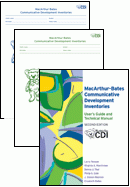*DISCONTINUED (*NEW EDITION in Alternatives below)
Use the CDI to get a reliable view of a child’s communicative development.
What is it?
Standardized parent-completed forms that help professionals screen young children’s emerging language and communication skills
Which developmental areas does it screen?
Language and communication skills
What age range does it cover?
8–37 months (may also be used with older children who have developmental delays)
What components are there?
- CDI includes
- CDI: Words and Gestures (for use with children 8–18 months)
- CDI: Words and Sentences (for use with children 16–30 months)
- CDI-III (for use with children 30–37 months)
- User’s Guide and Technical Manual
The MacArthur-Bates Communicative Development Inventories (CDI) provide a systematic way for professionals to use parents as informants regarding their child’s language. They enable professionals to tap into parents knowledge about their young children’s communicative development for use in screening and developing a prognosis for children with language delays. It also ensures they are meeting mandates for including parent input in child evaluation procedures.
The goal of the CDI is to yield reliable information on the course of language development from children’s early signs of comprehension, to their first nonverbal gestural signals, to the expansion of early vocabulary and the beginnings of grammar.
With the CDI, professionals tap into parents' day-to-day knowledge about their children’s language and communication skills. The User's Guide and Technical Manual provides complete instructions, technical reports, norms, and guidance on interpreting scores for various subpopulations.
The Words & Gestures forms tap into parents' day-to-day knowledge about their children’s language and communication skills between the ages of 8 and 18 months.
The Words & Sentences forms tap into parents' day-to-day knowledge about their children’s language and communication skills between the ages of 16 and 30 months.
No additional information available for this item.

 Proud to be Canadian
Proud to be Canadian



